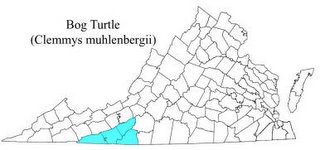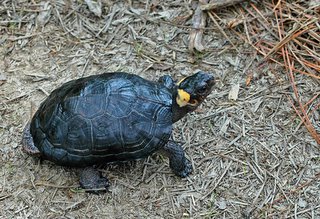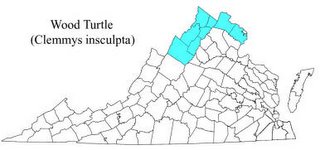Federal Threatened and (or) State Endangered Turtles of Virginia’ Blue Ridge Mountains

We have two turtles (Order: Testudines) in The Blue Ridge Mountains of Virginia that are Federal Threatened and (or) State Endangered. One is the bog turtle (Clemmys muhlenbergii) which lives in bogs, swamps and wet meadows in the southern Blue Ridge Mountains; primarily the Blue Ridge Plateau. It is Federal Threatened & State Endangered. The other Blue Ridge endangered turtle is the wood turtle (Clemmys insculpta) and is found in the northern portion of the state and is listed as State Threatened.
The bog turtle, Clemmys muhlenbergii, is a small turtle that prefers high elevation, mountain wetlands. With a maximum carapace length of approximately four inches, this little turtle was once thought to be common. It is extremely habitat-specific, requiring an open bog with freshwater seepage. Speculation as to how these bogs were once maintained is that bison, elk, and beaver played a major role grazing them clear. The eradication of many of these large mammals and the encroachment of man combined to spell disaster for this diminutive species.
Presently, the bog turtle is being assaulted on two fronts. First, its size and temperament make it attractive to the pet trade and collection, both private and commercial, has reduced the wild population. Secondly, and perhaps most devastating, is habitat destruction. Many wetland sites have been drained for agriculture, business, and roadways. Because of these factors, the bog turtle was placed on the federal endangered species list. The northern population's status is threatened, and receives full protection under the U.S. Endangered Species Act. The southern population is protected due to similarity of appearance only, pendi
 ng the results of ongoing survey work.
ng the results of ongoing survey work.This is a small freshwater turtle that has a maximum carapace length of 4.5 inches. The carapace is roughened with growth rings that are dark brown to black, sometimes with irregular radiations or markings, and has a smooth posterior rim. This species is not sexually mature until 6 years of age. It breeds from late April to early June, in shallow water and on land, and eggs hatch in the Fall. There may be two clutches/year and it takes from 50-59 days for the eggs to hatch. The eggs are laid in shallow nests in grass tussocks, moss, or soft soils. This species is active only during April, May, June and September and aestivates during high temperatures. It is usually seen only during the early spring and during the nesting season because the dead and matted grasses and sedges form a dense ground cover during late spring and summer. During the winter this turtle hibernates below the frost depth in holes, muskrat burrows, in sedge clumps, or in the mud of waterways. The mean home range is 3.2 acres. Bog turtles bask during midday on grass mats or in shallow rivulets.
This species is found in Virginia only in the southern Blue Ridge Plateau above 610 meters elevation. It inhabits sphagnum bogs or wet sedge meadows in or near slow moving streams with a muddy bottom. The highest populations occur in the shrub stage of forest succession. Alder, skunk cabbage, and sedges are common plant associations.
The bog turtle eats berries, insects and dead animals. Known prey includes a variety of insects, earthworms, slugs, snails, millipedes, crayfish, tadpoles, duckweed, seeds of pondweed (Potamogeton) and sedges (Carex), blackberries and strawberries.

The medium sized wood turtle (Clemmys insculpta) is found in the northern portion of the state and is listed as threatened. Whereas many people think of turtles as simple, the wood turtle exhibits an interesting and complex behavior know as "worm stomping." Wood turtles in other states have been observed to stomp their legs on the ground for at least 15 minutes, waiting for earthworms. It is thought that the stomping resembles falling rain vibrations, and the earthworms come to the surface as a result.
This is a medium-sized turtle, up to 9 inches in length, with a keeled, sculptured carapace. The broad, low carapace is rough, and each large scute supports an irregular pyramid formed by a series of concentric growth ridges. The skin is dark brown to black, often with some orange or red pigment on the forelegs and neck. The tail is rather long. Wood turtles lack the bright orange patch on the side of the head found in the bog turtle. Hatchling wood turtles are gray to brown and lack red or orange pigment on the head and legs. Known hatchling emergence dates in Virginia are from June to August. Clutches of 7-14 eggs are most common.
 Wood turtles emit a courting whistle sounding like a tea kettle. This species is usually found roaming alone except when mating. It is a very good climber. It has a rather restricted home range and some individuals turn up year after year in the same place. This species is generally terrestrial during the warm part of the year, and aquatic during cool spells and hibernation. It hibernates in deep pools or under the mud or sand bottom of its waterway, or just sits on the bottom or crawls up under the overhanging roots of trees along the bank. Virginia specimens observed in the winter were under submerged logs, in beaver lodges, and in muskrat burrows. Although highly terrestrial, wood turtles must remain in moist habitats as they experience a greater evaporative water loss than the more terrestrial box turtles. Populations have declined due to degradation of aquatic habitats, loss of wetlands, fragmentation of habitats, urbanization, being killed by vehicular traffic, and from the collection of adults and juveniles for the pet trade.
Wood turtles emit a courting whistle sounding like a tea kettle. This species is usually found roaming alone except when mating. It is a very good climber. It has a rather restricted home range and some individuals turn up year after year in the same place. This species is generally terrestrial during the warm part of the year, and aquatic during cool spells and hibernation. It hibernates in deep pools or under the mud or sand bottom of its waterway, or just sits on the bottom or crawls up under the overhanging roots of trees along the bank. Virginia specimens observed in the winter were under submerged logs, in beaver lodges, and in muskrat burrows. Although highly terrestrial, wood turtles must remain in moist habitats as they experience a greater evaporative water loss than the more terrestrial box turtles. Populations have declined due to degradation of aquatic habitats, loss of wetlands, fragmentation of habitats, urbanization, being killed by vehicular traffic, and from the collection of adults and juveniles for the pet trade.In Virginia, this species has a restricted range extending from Arlington and northern Fairfax counties westward through Loudoun and Clarke counties to Frederick, Warren and Shenandoah counties. It has recently been found in northwestern Rockingham County. It inhabits a variety of habitats, such as forested floodplains, fields, wet meadows, and farmland, as long as there is a creek or stream nearby.
The wood turtle eats both animal and plant food items, including berries, herbs, algae, moss, fungi, grass, insects, mollusks, earthworms, dead fish, tadpoles, newborn mice and other turtles' eggs. It will forage on the ground, in the water, in herbaceous vegetation, and on logs.
Please, if you come across either of these turtles, let them live and leave them to go on their way!
Technorati Tags: [Blue Ridge][Blue Ridge Mountains][Federal Threatened][State Endangered][Blue Ridge Plateau][bog turtle][Virginia][wood turtle][Arlington][Fairfax][Loudoun][Clarke][Frederick][Warren][Shenandoah][Rockingham][National Forest]












0 Comments:
Post a Comment
<< Home